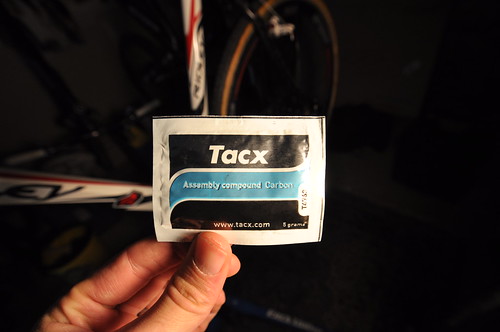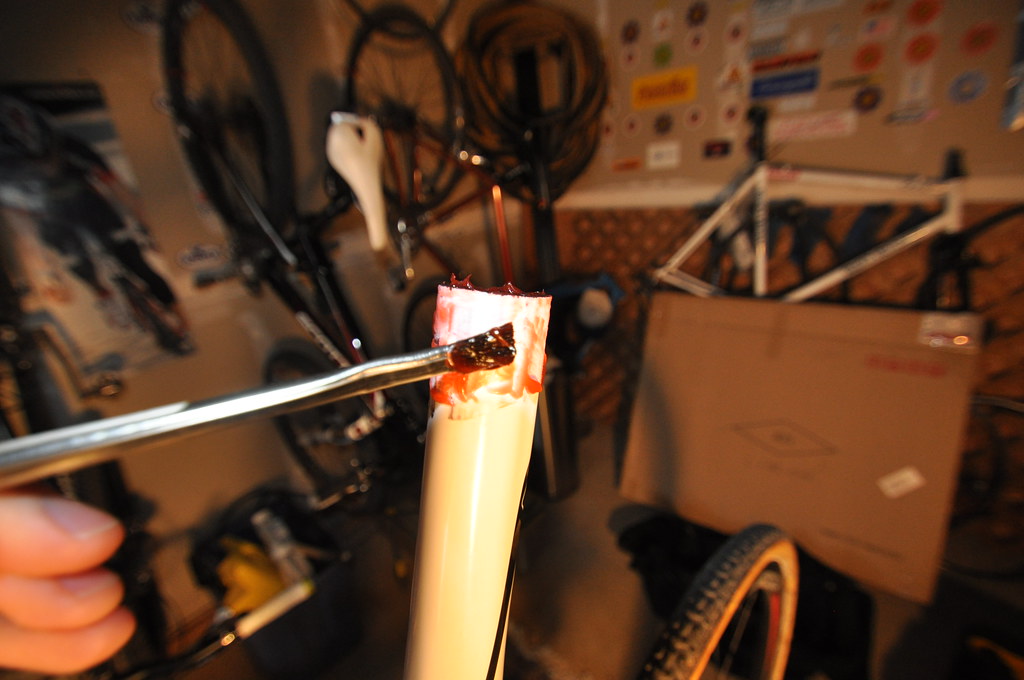Entries in how to instructions (12)
Assembling The Ridley X-Night Seat Mast | What I learned from Ridley
The Ridley's have treated me unbelievably this seson. A way better arrow than the Indian shooting it. The X-Night is a pretty sophisticated bike and is one of the new-generation frames featuring a carbon seat mast in favor over a seat post. This adds rigidity (especially in large frames like my 58cm) while reducing overall weight.
Out of the box, the X-Night's seat mast must be cut to the rider's appropriate height. The frame comes with a number of shims of various thicknesses as well to get very precise on the positioning. After cutting and getting my seat height dialed, my first couple of mounts and re-mounts demonstrated a noticeable "pop" emanating form the seat mast. A little concerning to say the least yet I couldn't diagnose the problem.
At Interbike, I had the privilege of meeting the Ridely bike crew from Belgium and their US counterparts from QBP and talked through my issue. Very quickly they walked me through the process and I wanted to share that with you as well, family of Ridley X-Night owners.
If you have a 'just-out-of-the-box' X-Night, ensure your shop has this set of instructions for ensuring proper cutting:
In my case, these were followed but even a super slight deviance from the required tolerance can result in the audible popping noise. Essentially, the issue results from the top of the mast not properly sitting in the 'bay' of the aluminum mast clamp. A remount will occasionally cause an ever so slight 'pull' from the top of the mast and yet another occasional mount will 'pop' it back into place...thus the audible noise.
The solution to eliminating the pop is a simple one however and comes direct from the Ridley engineering team and is practiced by both the Fidea and Sunweb Projob team mechanics on their rider's X-Nights in the Motherland.
First remove your seat mast clamp. Ensure you thoroughly clean the inside of the aluminum clamp and the contact area on the seat mast.
Next, use the recommended carbon/aluminum assembly paste which is Tacx (red compound). FSA and Ritchey also make what appear to be the same paste (and is probably all made in the same factory regardless...).Use an acid brush and coat the sides and top of the carbon.


Re-attach the seat mast clamp and tighten to the prescribed tolerances (inscribed on the seat mast clamp itself).
Voila you are done! I have not experienced the popping since I added the compound.
Hoogie
The WK's are underway and the Belgians are PISSED thus far after the Juniors and U-23's no-showing on either podium. But, at least they look PRO. Note Bosman's tall-boy sock customization. At-a-boy, Bos! There's going to be HELL to pay if there's not the light blue tricolor on the podium tomorrow.
REPLAY! How to build your own port-o-barriers
I've had like a zillion emails come in about this old post asking where it is, so I guess it's time for a re-run! You can always use the Lijit or Blogger search engines on the blog itself to search for things you are looking for as well!
Proceed to: How to build your own Port-o-Barriers
Working on the Reflex rims....
 So I took my lunch break today by going into the garage and working on these Reflex rims of mine with the new tubulars all glued on. I had mad issues with the green compound SwissStop brake pads (meant for ceramic and aluminum) due to unbearable squeaking and chatter in the front and rear. Further, I got some glue on the sidewalls of the braking surface of the Reflex rims. I initially swapped out the SwissStops for standard Shimano wet/dry pads for aluminum rims but I am STILL getting unbearable chatter. I got myself a Mavic Brake Surface Stone (per Nick's instructions!) as seen in the picture in this post and worked the rims to death. The stone is more like a big gritty eraser. $29 bucks!! D'oh! I also used some acetone to work out the bit of glue on the rim surface. While a wee bit better, it's still WAY too grabby. Modulation is nonexistent and the choppiness and stutter returns under hard braking. I wonder if it just needs some grit and surface grinding. The Shimano pads work SWEET with my Ceramic Mavic clincher rims.
So I took my lunch break today by going into the garage and working on these Reflex rims of mine with the new tubulars all glued on. I had mad issues with the green compound SwissStop brake pads (meant for ceramic and aluminum) due to unbearable squeaking and chatter in the front and rear. Further, I got some glue on the sidewalls of the braking surface of the Reflex rims. I initially swapped out the SwissStops for standard Shimano wet/dry pads for aluminum rims but I am STILL getting unbearable chatter. I got myself a Mavic Brake Surface Stone (per Nick's instructions!) as seen in the picture in this post and worked the rims to death. The stone is more like a big gritty eraser. $29 bucks!! D'oh! I also used some acetone to work out the bit of glue on the rim surface. While a wee bit better, it's still WAY too grabby. Modulation is nonexistent and the choppiness and stutter returns under hard braking. I wonder if it just needs some grit and surface grinding. The Shimano pads work SWEET with my Ceramic Mavic clincher rims.
Any experts out there with advice??
RM 'Crossers clinic: Sunday @ 10AM @ Elks
I'm throwing a free clinic for a couple of hours on Sunday at Elk's in Boulder. Feel free to come and get your cross on. We'll be doing some very specific barrier technique training to attempt avoiding looking like 'za ugly amerikan'. smooth is good and will help you enjoy your 'cross more.
See ya at 10 if'n yer interested.
Note that you do NOT have to be an RM'er! If you care to learn a bit and have some fun, join in. MTB's are fine, just remove the bar ends and bottle cages.
What a difference a day makes
So, from piss and moan on Thursday to taking the day off Friday, I feel like a new man. Unbelievable. I have to remember to actually do that every now and again. It's like someone set the reset button to reboot me.
Today was epically gorgeous here in zee Repoobleek. Bobby and I got out for a 100% cross focused training ride this AM. We both feel air changing.
We did 20 x 20's up Poorman's today to work on maintaining porting technique while being under stress. You are climbing this slog of a dirt road suffering but the goal is to be able to maintain your composure (e.g. on/off bike technique) while suffering. In the 59th minute of a cross race, you'll be thanking me for this Bobby. You want to be able to be as smooth and efficient when the body feels like it can't. Suffering up this slog a few times a week is helpful for that late race assurance.
We moved on to Elk's and set up shop. Slow speed technique training over the PVC's. Fun. Took some pics and vids.
What did YOU do to get ready for cross today kids?!!
The tubular gluing hath begun...
This is going to be a multi-day project but now is about the time I need to start. So what do I need to begin this annual rite of cyclocross passage each, fall. Here goes:
a) Beer. Pick something Belgian.
b) Disposable gloves. Get a big box of the thicker Nitrile kind. Latex is too thin for this type of work. They're great for bike maintenance too!
c) Brushes. Buy a shed load of them. They are "acid" brushes and any hardware store has 'em. 29 cents.
d) Tubular glue. I get the toothpaste dispenser kind as it is easier to apply IMHO. I happen to use Vittoria but Conti is good too.
e) Sharpie pen: When you get these things glued, write in small print somewhere on the sidewall the date you finished gluing. Helpful to know as the glue truthfully has a shelf life. I would never go 2 cross seasons on a glued wheel personally.
f) Stretched tires. Do NOT start this unless you have had your new tubulars stretching for 2 weeks minimum, again IMHO. When it comes time to put the tire on the rim for good, it will make your life infinitely easier when stretched.
g) How you do it? I don't want to start a religious debate here but I have found success as follows: Do a tubular a night. Apply 3 coats each to tire and rim. Wait 20 minutes in between each coating. Slightly fill the tubular with air before putting the glued tire to the glued rim. When attached, fill that thing up to about 45% with air. Just enough to allow the pressure from the air to really squish the glue in place and removing any air pockets between the cotton and the carbon (or aluminum). Let it sit in a cool dark place for a week.
Thanks to Dwayne, my Sinsei, at Boulder Cycle Sport for teaching me.
How to build your own port-o-barriers (BostonCross style)
So, I'm thinking I am all that plus tax in designing my little PVC training barriers when I see a google alert sniff out this gem from the lads of BostonCross. Their approach is fairly straightforward but require the need to 'stake' themselves into the ground where mine use a legged approach. You can see the article here on their great 'cross focused site. Or I've JPG'd their freely accessible PDF here:What did you do today to get ready for 'cross?
Tall boys on a tall boy drinkers budget
So, if you're like me, you have about a zillion pairs of bike socks you don't wear any more and all piled away in a drawer. Many of them are invariably ankle panties they're so low, and you're avoiding them 'cause they're not hip any more. So, here's how you can revive 'em and get more shelf life out of your ancient Pedros socks making 'em all tall and PRO like.
Note, this works best with Defeet socks, but many socks are stitched just like these.
First, locate your once retired pair of socks:
Flip 'em inside out and stretch them like this to make the stitching more exposed:
Grab a set of shears and carefully cut the stitching. Be careful not to go through the other side! Lastly flip 'em inside out and pull those babies on! You're now totally PRO!
Lastly flip 'em inside out and pull those babies on! You're now totally PRO!
How to build your own port-o-barriers
Who's thinking cyclocross! I am! I am! In fact, I never stop thinking about it. I just watched the 2000 Worlds again for the zillionth time last night. Love watching Groovy-daal work the mud. In other words, I watch and study 'cross as an obsession. Rewinding again and again and again to see how Ik Sven takes a line with insanely low tire pressure in the Dugasts; *or* how Erwin ports the bike Belgie style, finessing the bike on to his shoulder and arm around the head tube in such syncopation you need to see it in slow motion; *or* how De Clercq stutter steps his muddy climbs to conserve energy.
It's all in the details and that's where cross races are won and lost.
So, what makes a cross rider great? Technical savvy. I love putting pain to roadies who fumble through 'cross courses like a deer trying to walk across ice. 'Cross, if you haven't figured it out yet, is a game of not only sheer maintenance of power but also of utter grace. The power keeps you at the front but the grace ensures it is damn near impossible to bridge to you.
Technical savvy off the bike is what makes the best cross riders the best. And to be specific, it's the barriers that above all are the bottleneck and gating factor (no pun intended) to those desiring a podium spot. When you can flow effortlessly through the barriers and reduce all amounts of friction through your transition and get back on the bike fluidly, folks without those same skills fumble, waste energy and when they finally remount and get going again, they have to add those additional watts of power to get back on your wheel. Compound that wattage expenditure over the course of 60 minutes and those without your barrier skills have burned WAY too many matches.
So, how do you get better? Practice, dummy. And to practice you need barriers. Back in the day, we used to drive our cars to a schoolyard and pull out wooden boards we'd made. That is retarded, and this will enable you to be mobile by bike, carry 'em in a back pack and have LOTS of barriers as well to set up multiples. So in my quest to make American 'crossers LOOK way better than our stereotypical bumbling selves, behold my secret plans.
What do you need?
For 4 complete barriers you need
- 16 22" sections of 1/2" PVC tubing (for the top bars).
- 16 18" sections of same 1/2" PVC tubing (for the legs). NOTE: you may want to go as high as 19" for a bit more height on the leg tubes. The 18" tubes are high but just slightly lower than the UCI height.
- 8 3-way joins for 1/2 tubing (buy extra 'cause they break)
- 12 2-way joins for 1/2 tubing (buy extra 'cause they break too)
This is what the 2 and 3 way sections look like (the 2 way on the left, 3 way on the right). You can find them near the PVC tube section in your hardware store.
I drafted up a little diagram for y'all in Visio to show you how this stuff fits together:
When you get them all cut up, throw some stickers on the long top sections. This makes it SUPER easy when you get to your course site and pull 'em out of your back pack to know which are the top and which are the leg tubes. They all fit nicely into a backpack as follows:
And when you are at your site, set 'em up (takes about 2 minutes) and begin your practicing to dominate the competition! RM'ers training using the port-o-barriers in action:


 Wednesday, November 25, 2009 at 4:18PM
Wednesday, November 25, 2009 at 4:18PM


